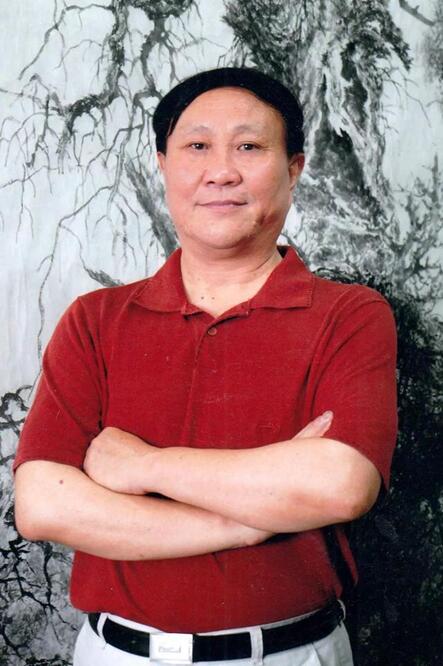
张介宇,胡杨艺术研究院院长、北京胡杨礼赞书画院院长、中央文史馆书画院研究员、人民大会堂金色大厅胡杨礼赞创作者、中国国际书画艺术研究会理事、中国美术家协会会员、岭南大师黎雄才入室弟子。
Zhang Jieyu, President of Huyang Academy of Art, President of Beijing Huyang Lizan Academy of Calligraphy and Painting, Researcher of the Academy of Calligraphy and Painting of the Central Museum of Culture and History, Creator of Huyang Lizan in the Golden Hall of the Great Hall of the People, Director of China International Association of Calligraphy and Painting Arts, Member of China Artists Association, and disciple of Lingnan Master Li Xiongcai.
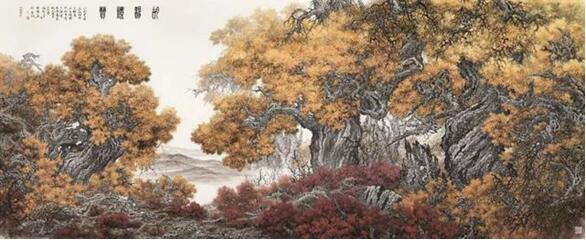
人民大会堂金色大厅创作巨幅《胡杨礼赞》
2015年6月 350x1000cm
其作品《万壑松云》被中南海悬挂收藏,《长青图》被毛主席纪念堂收藏,并且三次为人民大会堂创作巨幅国画作品:《洗涤万壑无纤尘》(2010年)、《幽谷飞流图》(2011年)、《胡杨礼赞》(2015年)。出版著作有《张介宇画集》(陕西人民美术出版社)、《当代中国画名家——张介宇精品选》(天津人民美术出版社)、《胡杨礼赞(长卷)》(人民美术出版社)、《张介宇画选》(人民美术出版社)等。
His works "Wan Gu Song Yun" have been hung in the Central South China Sea and "Chang Qing Tu" has been collected in Chairman Mao's Memorial Hall, and three times he has created giant Chinese paintings for the Great Hall of the People: Washing Wan Gu without Fiber Dust (2010), Valley Flying Flow Map (2011), Hu Yang Ritual Praise (2015). Published works include Zhang Jieyu Painting Collection (Shaanxi People's Fine Arts Publishing House), Contemporary Chinese Painter Zhang Jieyu Excellent Selection (Tianjin People's Fine Arts Publishing House), Hu Yang Lizan (Long Volume) (People's Fine Arts Publishing House), Zhang Jieyu Painting Selection (People's Fine Arts Publishing House), etc.
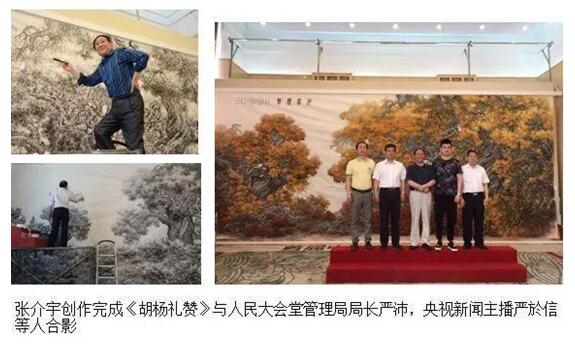
人类的自传
——观《胡杨礼赞》巨画有感 (节选)
凤凰卫视评论员 李可染艺术基金会秘书长 王鲁湘
站在《胡杨礼赞》巨画前,我不能不肃穆而立,向那些或荣或枯的伟岸身躯敬礼;我也无法不“视通万里,思接千载”,向那些或立或卧的伟大灵魂叩问。
我一边摩挲着像铮铮铁骨的胡杨枝,一边看着张介宇,心中充满无限感慨。一个经历了这么多苦难的人,却不失其赤子之心,对生活只存感激,对他人永怀感恩,对生命满怀热爱,对祖国无限忠诚,对艺术精益求精。一个人,处贫贱而不移,居富贵而不骄,穷不改其乐,达不变其志,永远只对高尚美丽的事物心存景仰,这难道不是贤人吗?我相信,他以如此巨大的热情和精力投入到《胡杨礼赞》的创作中,一定是那片沙漠中的胡杨林从灵魂深处激起了他的共鸣。他在题记中写道:“胡杨不屈不挠的精神深深地震撼了我的灵魂,我为它不眠,为它忘食,将自己的生命与他千缠万绕的交织在一起,熔铸在一块。无数个晨晓夜昏,年复一年的似水流过,我与胡杨难解难分,同语共舞。”是的,《胡杨礼赞》其实就是张介宇的自传,唯其如此,它在如此人格化,每一棵树,似乎都是他生命中的某个片断,某段身影。狂歌也好,浩叹也好,长啸也好,低回也好,沉默也好,那都是生命热真的精彩华章。“凡存在的,必永生。”
Human Autobiography
—— Feelings on the Great Paintings of Poplar Praise (Excerpt)
Wang Luxiang, Secretary-General of Li Keran Art Foundation, a commentator of Phoenix Satellite TV
Standing in front of the giant painting Euphorbia, I can not stand solemnly and salute those great bodies which are either honorable or withered; nor can I ask those great souls who are standing or lying without "seeing thousands of miles and thinking for thousands of years".
I looked at Zhang Jieyu while rubbing Populus euphratica branches like clanking iron bones. My heart was filled with infinite emotion. A man who has experienced so many hardships, but does not lose his childlike heart, is only grateful for life, always grateful for others, full of love for life, infinite loyalty to the motherland, and strive for the best in art. Isn't it a wise man who lives in poverty without moving, lives in wealth without arrogance, never changes his happiness, never changes his ambition, and always admires only the noble and beautiful things? I believe that he devoted so much enthusiasm and energy to the creation of Euphorbia euphratica, it must be that Euphorbia euphratica forest in the desert aroused his resonance from the depths of his soul. In his inscription, he wrote: "The indomitable spirit of Populus euphratica deeply shocked my soul. I forgetted food for it, and mingled my life with his endless entanglement and cast it together. Countless mornings and nights, year after year like water, I and Populus euphratica indissoluble, dance with the same language. Yes, "eulogizing the poplar" is actually Zhang Jieyu's autobiography, but that is the only way, it is so personalized, every tree seems to be a part of his life, a figure. Mad songs, great sighs, long howls, low returns and silence are all wonderful chapters of life's enthusiasm. "Whoever exists will live forever."
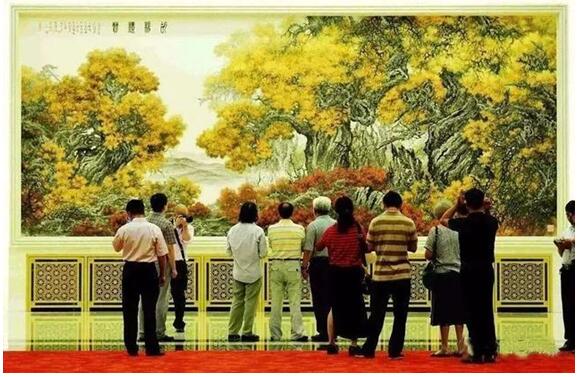
张介宇作品《胡杨礼赞》,悬挂于人民大会堂金色大厅
我逡巡在数十米长的画卷之下,分明听到命运敲门的声音,听到贝多芬《第五交响曲》和《第九交响曲》在胡杨林的上空反复交替的轰响。生与死,命运与英雄,悲怆与欢乐,多个主题纠结缠绕,时而激越冲突,时而把手言欢。最后,命运敲门之声骤退,所有的搏击归于沉静,万籁俱寂。此时,我仿佛看到沙丘上坐立倒卧的都佛。是的,胡杨的生命史最能表象佛教所言之成、住、坏、空。千年而成、千年而住、千年而坏、千年而空,然后又是轮回。此是大劫数,亦是大悲怆,又何尝不是大欢喜?
我看此画,悲欣交集。
为伟大的民族和时代见证
——读张介宇《胡杨礼赞》有感(节选)
四川大学教授 中国美术家协会理论委员会委员 林木
I wandered under the tens of meters long picture scroll, clearly heard the sound of fate knocking on the door, heard Beethoven's "Fifth Symphony" and "Ninth Symphony" repeatedly alternating sounds in the sky of Populus euphratica. Life and death, fate and heroes, sorrow and joy, multiple themes entangled, sometimes fierce conflict, sometimes joyful words. Finally, the sound of fate knocking on the door suddenly receded, all the fighting returned to silence, all sounds of silence. At this point, I seem to see the Dunhua sitting upside down on the sand dunes. Yes, the life history of Populus euphratica can best represent what Buddhism says: success, residence, destruction and emptiness. Thousands of years, thousands of years to live, thousands of years to bad, thousands of years to empty, and then reincarnation. This is a great disaster, but also a great sadness, why not a great joy?
I look at this picture, mixed with joy and sorrow.
Witness for the Great Nation and the Times
—— Reading Zhang Jieyu's Praise of Poplar Euphorbia (excerpts)
Professor Lin Mu, Member of the Theoretical Committee of China Artists Association, Sichuan University
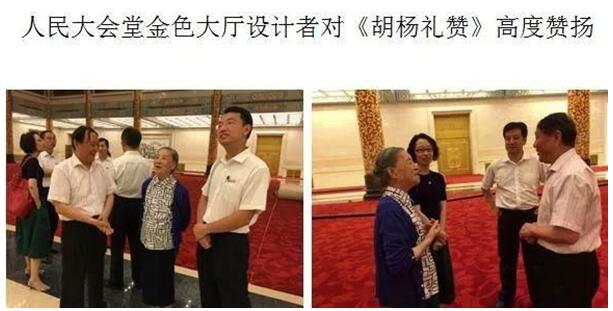
张介宇是适合画大画的。与当今国画界强调笔墨至上的流行倾向不一样,张介宇是强化境界的。笔墨至上是明末清初以来文人闲适玩赏倾向的结果,它是适合扇面斗方小品表现的,是供文人手中把玩的。而对境界的追求,则是唐宋元至明中期的倾向。这种倾向要求造境,要求意与境谐,意从境生。故对造型有特别要求。要造型则要写生,要写生就要有细节再现的能力。清代以后不强调写生,即使写生也不强调细节,反而有“胜于丘壑为作家,胜于笔墨为士气”之说,贬丘壑造型,褒笔韵墨气,其结果不外或辗转模仿前人丘壑,或小情小趣玩笔弄墨,尽管笔墨越弄越精,而气数则越弄越小,其风气至今难变。
但张介宇先生喜欢的却是大境界、大气势,是巨幅宏制。这种大画面需要大造型,大造型又难离小细节,而这一切又有赖外师造化,搜尽奇峰。
Zhang Jieyu is suitable for big paintings. Zhang Jieyu strengthens his realm, which is different from the popular tendency of emphasizing the supremacy of brush and ink in today's Chinese painting circles. The supremacy of pen and ink is the result of the tendency of literati to enjoy leisure since the late Ming and early Qing dynasties. It is suitable for the performance of fanfanfandoudoufang sketches and is for the literati to play with. The pursuit of realm is the tendency from Tang, Song, Yuan to the mid-Ming Dynasty. This tendency calls for artistic conception, harmony between artistic conception and artistic conception, and artistic conception from artistic conception. Therefore, there are special requirements for modelling. To shape, we need to sketch. To sketch, we need to have the ability to reproduce details. After the Qing Dynasty, there was no emphasis on sketching, even if it did not emphasize details. Instead, there was the saying that "better than Qiu Qian as a writer, better than pen and ink as morale". The result was that Qiu Qian's style was derogated and his style was praised. The result was nothing more than imitating Qiu Qi of predecessors or playing with pen and ink with trifles, although the more refined the pen and ink, the smaller the number of tones was. Its atmosphere has remained unchanged so far.
But what Mr. Zhang Jieyu likes is the grand realm, the great momentum and the grand system. This kind of big picture needs big shape, big shape is inseparable from small details, and all this depends on the creation of foreign teachers, searching all the strange peaks.
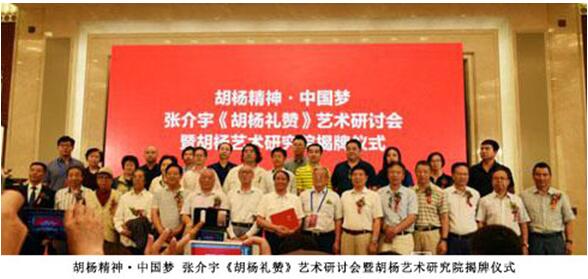

创作《胡杨礼赞》
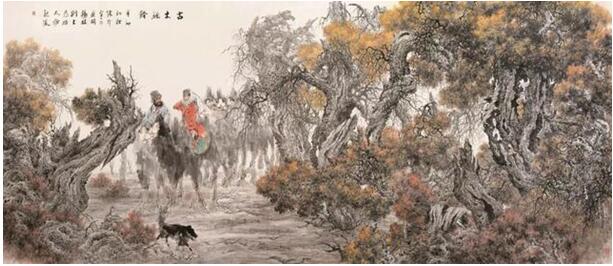
古木驼铃200cmx500cm 2011年(与刘大为合作)
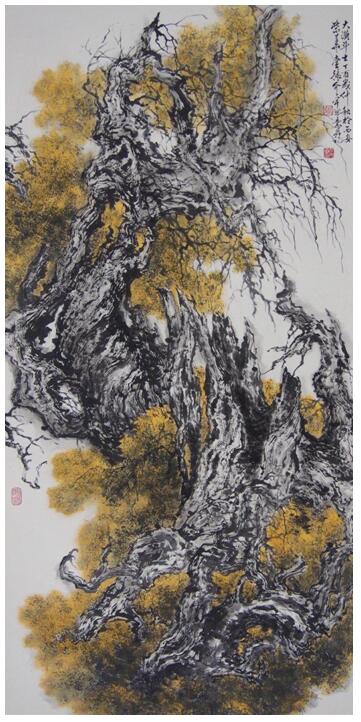
大漠斗士
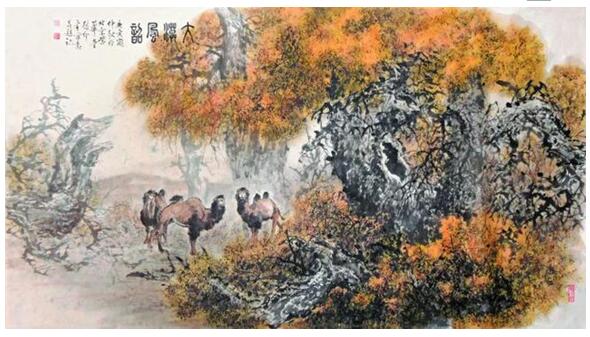
大漠英雄 95cmx177cm 2011年
(西北民航贵宾厅悬挂)
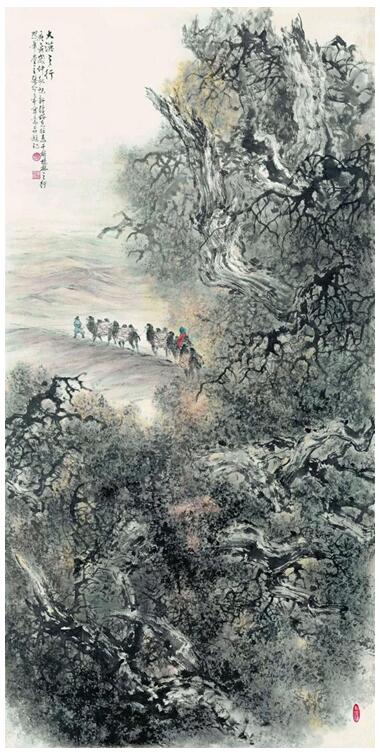
大漠之行
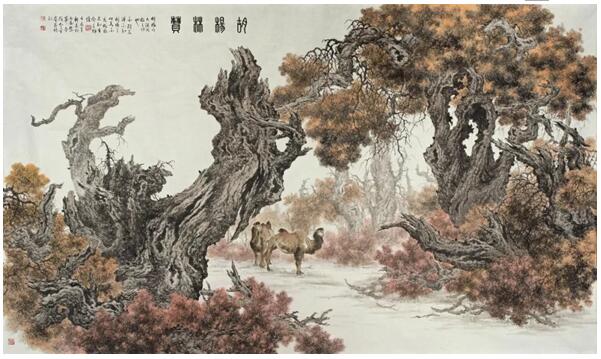
胡杨林赞—生生不息 20cmx480cm 2012年
(西北民航贵宾楼收藏悬挂)
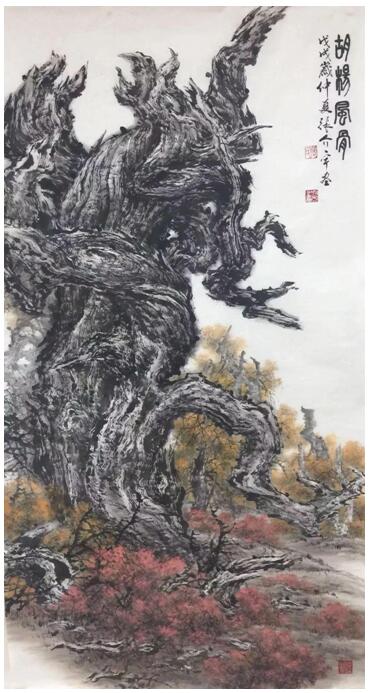
胡杨风骨

胡杨秋韵
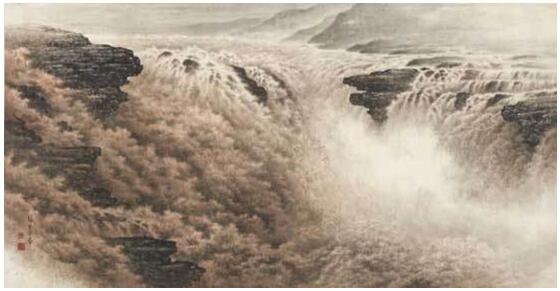
中华魂95×177cm2001年创作
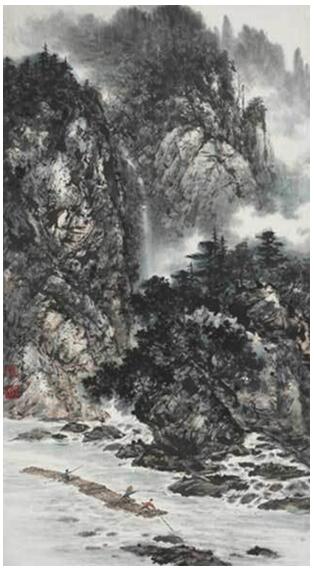
反照入溪翻石壁61cmx34cm 2007年